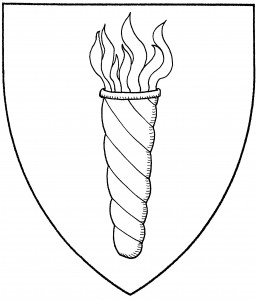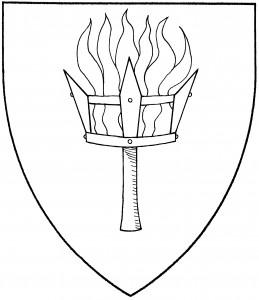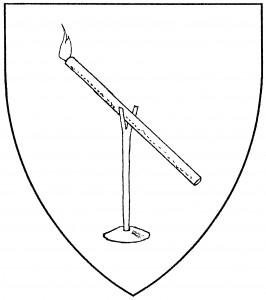A torch (also called a “flambeau”) is a source of light, consisting of a twist of hemp soaked in oil, and set in a holder; the holder was originally of wood, but by the end of period we find torches with long cylindrical metal holders used in processionals. The torch is a period charge, found in the canting arms (German Fackel) of Fackelstein, c.1340 [Zurich 447], upon which the illustration is based. The torch is always “enflamed”, or lit, even when not explicitly blazoned so.
A similar charge is the “firebrand”, which is simply a bit of burning wood. It’s depicted as a ragged staff with the top end enflamed; sometimes the ragged bits on the sides are enflamed as well. If blazoned “proper”, the brand is brown, the color of wood, with the flames gules and Or. The firebrand is found in the canting arms of von Brandis as early as c.1370 [Gelre 97]; the illustration shows a firebrand bendwise.
There is also the “cresset” or “fire-basket”, a metal framework containing flame, as shown at the top of a beacon; it was a badge of John Holland, Duke of Exeter, d.1446 [HB 100], and of Henry V [Bedingfeld 129]. Finally, of Society-unique charges, we have the “rushlight”, a reed whose pith is soaked in oil, and whose upper end is lit. (The illustration shows a lit rushlight mounted in a stand.)
For related charges, see brazier, candle, lamp, lantern.
Alan Stevenson bears: Per pale argent and azure, three torches counterchanged.
Nikolaus Hildebrand bears: Argent, a firebrand bendwise proper enflamed and an orle of fleurs-de-lys gules.
Richard Fenwick bears: Argent, a rushlight bendwise proper, the dexter chief tip enflamed Or, supported by a three-legged iron stand sable.
Odette de Saint Remy bears as a badge: A cresset gules enflamed Or and argent.



